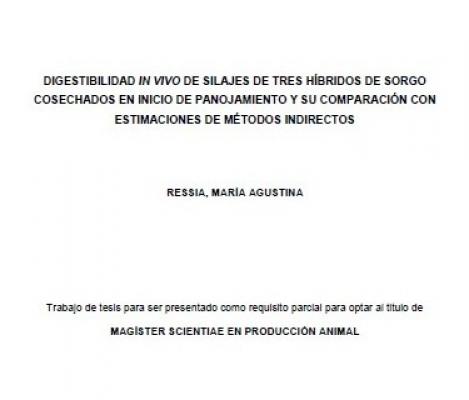Ver ítem
- xmlui.general.dspace_homeCentros Regionales y EEAsCentro Regional Buenos Aires SurEEA Cuenca del SaladoTesisxmlui.ArtifactBrowser.ItemViewer.trail
- Inicio
- Centros Regionales y EEAs
- Centro Regional Buenos Aires Sur
- EEA Cuenca del Salado
- Tesis
- Ver ítem
Digestibilidad In Vivo de silajes de tres híbridos de sorgo cosechados en inicio de panojamiento y su comparación con estimaciones de métodos indirectos
Resumen
El objetivo de este trabajo fue estimar la calidad nutritiva (composición química y digestibilidad in vivo) de silajes de fracción vegetativa de tres híbridos de sorgo: (granífero: G, silero azucarado: A y silero bmr: bmr) y comparar la digestibilidad estimada por distintas metodologías (degradabilidad in situ, producción de gas in vitro y ecuaciones predictivas basadas en la composición química) versus la digestibilidad
in vivo. La digestibilidad in
[ver mas...]
El objetivo de este trabajo fue estimar la calidad nutritiva (composición química y digestibilidad in vivo) de silajes de fracción vegetativa de tres híbridos de sorgo: (granífero: G, silero azucarado: A y silero bmr: bmr) y comparar la digestibilidad estimada por distintas metodologías (degradabilidad in situ, producción de gas in vitro y ecuaciones predictivas basadas en la composición química) versus la digestibilidad
in vivo. La digestibilidad in vivo (materia seca: MS y fibra en detergente neutro: FDN) se midió en corderos alojados en jaulas metabólicas. La degradabilidad in situ se evaluó en novillos con fístula ruminal. La degradabilidad in vitro se estimó a partir de la producción acumulada de gas durante las 72 h de incubación. Se utilizaron las ecuaciones sumativa de Van Soest y la basada en el contenido de fibra en detergente ácido (FDA). Los silajes no se diferenciaron en el contenido de materia orgánica, MS, PB y FDN. El contenido de FDA fue mayor en el híbrido bmr, y el contenido de lignina fue mayor en los híbridos G y bmr. La digestibilidad in vivo de la MS fue similar entre silajes, aunque hubo diferencias pequeñas en la digestibilidad in vivo de la FDN. En la comparación entre las estimaciones de digestibilidad por métodos indirectos y la obtenida in vivo hubo interacción significativa entre híbrido por técnica, siendo la
degradabilidad efectiva al 8%/h la única estimación que no se diferenció de la digestibilidad in vivo en ningún híbrido. La exactitud de los restantes métodos para estimar la digestibilidad in vivo dependió del híbrido. Todas las metodologías detectaron diferencias entre híbridos que no fueron observadas in vivo.
[Cerrar]
The objective of this study was to estimate the nutritive quality (chemical
composition and in vivo digestibility) of stover silages of three sorghum hybrids (grain: G), high sugar: HA and bmr double purpose: bmr,), as well as to compare the digestibility estimated by different techniques (in situ degradability, gas production and
predictive equations from the chemical composition) versus the in vivo digestibility. The in vivo digestibility (dry matter:
[ver mas...]
The objective of this study was to estimate the nutritive quality (chemical
composition and in vivo digestibility) of stover silages of three sorghum hybrids (grain: G), high sugar: HA and bmr double purpose: bmr,), as well as to compare the digestibility estimated by different techniques (in situ degradability, gas production and
predictive equations from the chemical composition) versus the in vivo digestibility. The in vivo digestibility (dry matter: DM and neutral detergent fiber: NFD) was measured on lambs placed in metabolism stalls. The in situ degradability was measured using three
cannulated steer. The in vitro degradability was estimate from the accumulated gas production during 72 h of incubation.The predictive equations used to estimate digestibility were the summative of Van Soest and the based on the content of aciddetergent fiber (ADF). No differences were found among silages in organic matter, DM,
PC and NFD content. The content of the ADF was higher in the bmr and Lignin content was higher in the G and bmr hybrids. No difference in in vivo digestibility was found between silages, but small differences in the in vivo NDF digestibility were found. In the comparison among the in vivo digestibility and values estimated by indirect methods occurred significant interaction hybrid x methods, being the ED at 8%/h the only estimation that did not differ from the in vivo digestibility in any hybrid. The accurate to the other indirect methods for estimation in vivo digestibility depend on hybrid. All
techniques detected hybrid differences that were not observed in vivo.
[Cerrar]

Autor
Director de Tesis
Descripción
Tesis para obtener el grado de Magíster Scientiae en Producción Animal, de la Universidad Nacional de Mar del Plata, en junio de 2007
Fecha
2007-06
Editorial
Facultad de Ciencias Agrarias, Universidad Nacional de Mar del Plata
Formato
pdf
Tipo de documento
tesis de maestría
Palabras Claves
Derechos de acceso
Abierto
 Excepto donde se diga explicitamente, este item se publica bajo la siguiente descripción: Creative Commons Attribution-NonCommercial-ShareAlike 2.5 Unported (CC BY-NC-SA 2.5)
Excepto donde se diga explicitamente, este item se publica bajo la siguiente descripción: Creative Commons Attribution-NonCommercial-ShareAlike 2.5 Unported (CC BY-NC-SA 2.5)


